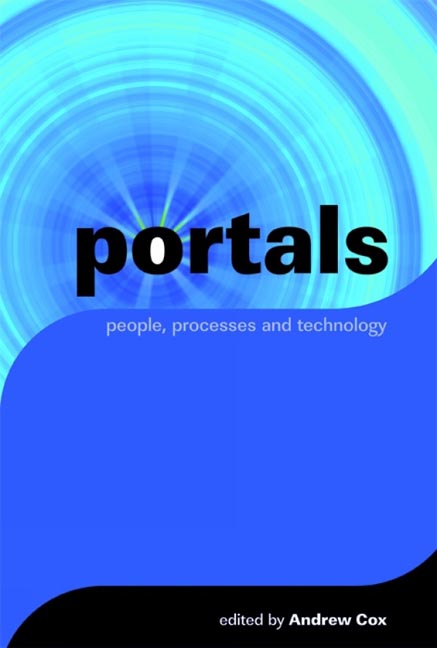Book contents
- Frontmatter
- Contents
- Introductory preface
- Section 1 Core themes
- 1 Definitions and debates
- 2 Portals or filters? Identifying quality on the internet
- 3 Portal architectures
- 4 Personalization initiatives in the public and academic domains
- 5 User needs analysis and evaluation of portals
- 6 Managing portal services
- Section 2 The library and the portal
- Section 3 The portal in the corporate sector
- Section 4 Portals in the public sector
- Section 5 The future
- The contributors
- Index
6 - Managing portal services
from Section 1 - Core themes
Published online by Cambridge University Press: 09 June 2018
- Frontmatter
- Contents
- Introductory preface
- Section 1 Core themes
- 1 Definitions and debates
- 2 Portals or filters? Identifying quality on the internet
- 3 Portal architectures
- 4 Personalization initiatives in the public and academic domains
- 5 User needs analysis and evaluation of portals
- 6 Managing portal services
- Section 2 The library and the portal
- Section 3 The portal in the corporate sector
- Section 4 Portals in the public sector
- Section 5 The future
- The contributors
- Index
Summary
Introduction
During the mid- to late-1990s, portals were public websites: the first page displayed when connecting to the internet. They were simple and the same for all users. Typically, they represented the front page of search engines or the default home page automatically set by ISPs (internet service providers) for their subscribers. Portals were in effect gateways to a subset of websites selected from the world wide web as a whole. In this sense, the metaphors of ‘portal’ or ‘gateway’ were apt and readily understood.
Today, portals are private websites: personalized interaction between individuals and organizations. They are complex and customized to the individual user. This complexity is evident in the myriad portal services that have been established using numerous portal systems. The quantity and variation is now such that portals can be classified into various types, as identified by Ovum in their taxonomy of portals: Specialized Portals, Public Web Portals, Enterprise Portals, Workspace Portals and Knowledge Portals (Winkler, 2005).
This maturation reflects a progression from serving audiences to serving individuals. In focusing upon the individual – the customer – the concept of a portal has developed from being a gateway through which information services located elsewhere are accessed, to being an environment within which information services are consumed, whether located elsewhere or not. In this way, the portal is recognized as a destination in its own right and no longer strictly a gateway through which other services are accessed. In effect, the terms portal and intranet have become largely synonymous in many cases.
For those managing a portal service, the focus needs to be on the word ‘service’ rather than ‘portal’. The aim of a portal service can be expressed as ‘meeting the information needs of customers in pursuit of the organization's objectives’. It follows that while a portal service is dependent upon the systems (i.e. technologies) that underpin it, it is the organization's stakeholders who are the manager's primary concern. Specifically, this concern should be focused at the intersection of the customers’, suppliers’ and organization's interests. This is where a portal service is differentiated from the systems underpinning it. To be effective, the manager needs to maintain a certain distance from each of the three interests and, in particular, the underlying systems.
- Type
- Chapter
- Information
- Portalspeople, processes and technology, pp. 63 - 76Publisher: FacetPrint publication year: 2006



